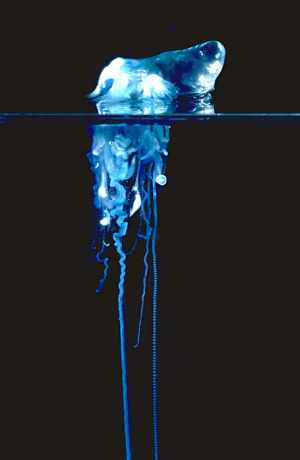
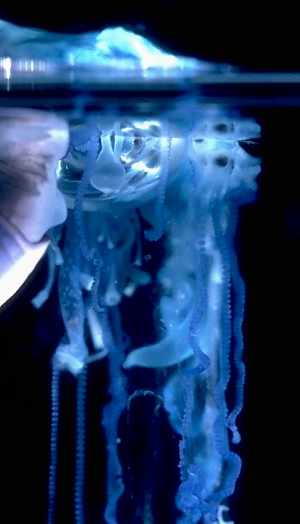
Physalia (Portugese man-o-war or Bluebottle)
PHOTO
Floating animal showing large flotation bladder and the specialised 'polyps' and trailing tentacles which hang beneath the bladder. Lower photo shows and enlarged section of the body beneath the water. Photos: Bill Rudman
Note: Messages on Porpita and Velella are also attached to this page.
Physalia is a Cnidarian [or Coelenterate] - a group of animals which includes the sea anemones, corals and jellyfish. One thing they all have in common are specialised stinging cells or nematocysts, which are often used to catch their prey. In Physalia they are used to catch fish, and to ensure the fish do not escape, the poison in the stinging cells is quite powerful. This is why they give us such a painful sting.
Physalia is a siphonophore, a specialised group of cnidarians in which each 'animal' is really a colony of highly specialised individuals. In Physalia, one individual forms a gas-filled float and the other individuals are specialised for feeding and digestion, or for reproduction, or to form the extremely long tentacles which contain the nematocysts which sting and capture their prey. In the lower photo part of the long stinging tentacles can be seen as a string of beads, each 'bead' containing a nematocyst. Other flask-like structures are the 'mouths' which secrete digestive juices and envelop captured food.
Bluebottles are found throughout the world and are usually only noticed when they are blown on to beaches during summer, upsetting our holiday plans. They can form great populations of animals in the open ocean and these 'blue fleets' often contain two other colonial cnidarians, Porpita and Velella. Porpita has a small transparent circular disc and many small tentacles radiating out around the edge, and Velella, whose common name is the 'by-the wind-sailor', has a more oval shaped disc with a prominent sail arranged obliquely along the disc.
A number of molluscs including the nudibranchs Glaucus atlanticus, Glaucilla marginata and the Violet Snails Janthina, are specialised feeders on Physalia and the other floating cnidarians.
Authorship detailsRudman, W.B., 2002 (April 23) Physalia (Portugese man-o-war or Bluebottle). [In] Sea Slug Forum. Australian Museum, Sydney. Available from http://www.seaslugforum.net/find/physalia
Related messages
Physalia from Western Australia
February 13, 2004
From: Monika Stambergova
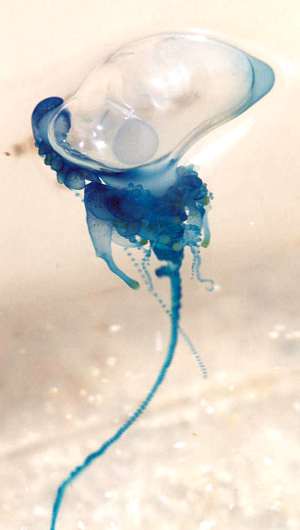
Dear Dr. Rudman,
I wish to ask you about some species I and my friend found in Western Australia last year. I took pictures of them, which I enclose. Is this Physalia sp.?
Date 7 September 2003, Cape Range Nat. Park - Ningaloo Marine Park, Camp Kurrajong, by the seashore. The animals were pretty small (pneumatophore about 2 cm long), but their stinging cells were quite powerful, anyway :-)). How many Physalia species do exist - at least we know about them?
With best wishes
Monika Stambergova
Czech Republic
stambergova@nature.cz
Stambergova, S., 2004 (Feb 13) Physalia from Western Australia. [Message in] Sea Slug Forum. Australian Museum, Sydney. Available from http://www.seaslugforum.net/find/12173Dear Monika,
Yes this is Physalia. I'm afraid the taxonomy of Physalia is outside my field of expertise. Some say the Atlantic species is different from the Indo-West Pacific but there doesn't seem to be any consensus. May be no-one has studied the question in any depth.
Best wishes
Bill
Velella velella
May 10, 2002
From: Glenn Nelson
Yesterday we found large numbers of Velella this washed onto the Santa Cruz beaches on the north side of Monterey Bay, California. I would never have known what they were, but a passing windsurfer said they were related to Portuguese Man-of-War.
A quick search led me to this site and also this page of excellent photos: http://www.imagequest3d.com/catalogue/surfacedrifters/index1.htm
Glenn Nelson
Santa Cruz, California
glenn@nelson.name
Nelson, G., 2002 (May 10) Velella velella. [Message in] Sea Slug Forum. Australian Museum, Sydney. Available from http://www.seaslugforum.net/find/6910Thanks Glenn,
Bill Rudman
What is it? From a school teacher in Los Angeles
May 2, 2002
From: Linda Slater
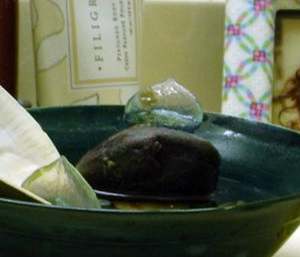
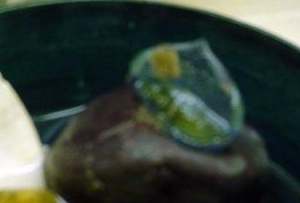
Hi...I'm an elementary school teacher and live in Playa del Rey, California. I walk my dog on the beach usually before sunrise...today I walked after sunrise and saw to my astonishment a beach filled with odd-looking little creatures. They were right near the water line and were about 2 to 4 inches long...no shell...with translucent fans on top of a dark grey/blue slug-like body. I am wondering if you have any idea what these things might be...I took some photos which I can share digitally. Please let me know what you think...thanks.
Linda Slater
lslater@attbi.com
Slater, L., 2002 (May 2) What is it? From a school teacher in Los Angeles. [Message in] Sea Slug Forum. Australian Museum, Sydney. Available from http://www.seaslugforum.net/find/6850Dear Linda,
Your animal is one of the wonderful group of animals that spend much of their life floating around on the surface of the ocean. Its common name 'By-the-wind-sailor' refers to the 'fan' or sail it has on top of its body. This sail is placed obliquely - just like the sail of a yacht, and there is continuing debate about whether those in the northern hemisphere have their sails angled differently from those in the southern hemisphere. Morris Abbott & Haderlie (1980) say that in California most animals are right-handed and so the prevailing northerly winds keep them off-shore. However if there are prolonged southerlies or westerlies they are driven on to the beaches.
Is it a slug? Unfortunately the name 'slug' is given to many soft bodied, apparently shapeless animals. True slugs are in fact molluscs, in fact snails that no longer have shells. This animal, whose scientific name is Velella velella is a cnidarian or coelenterate, a group of animals which includes sea anemones, jelly-fish and corals. Its often a good idea to put things you find washed up in a bucket if sea water. Often they have no skeleton so out of eater they just collapse and look shapeless and 'sluglike'. In water, Velella has a set of tenatcles which extend out below the sail and are used, like a sea anemone to catch the small prey it feeds on. You could describe Velella as an upside down sea anemone in which the trunk has become a flattened gas-filled float with a sail on top. It grows to about 8cm in length.
Although I normally only deal with true sea slugs, I have spent some time on this animal because it is part of a group of animals, including sea slugs, which live together, floating at the surface of the ocean. One other cnidarian is the Bluebottle or Portugese man-o-war, Physalia. Amongst the molluscs are the Violet Snails, Janthina and the aeolid nudibranchs Glaucus and Glaucilla. Both the snails and the slugs feed on Velella and Physalia.
If you click on the underlined names above you will find many photos and messages about this fascinating group of animals. The book I referred to above is a very useful guide to the invertebrate marine life of California. I am not sure if it is still available but I am sure many libraries would have copies.
• Morris, R.H., D.P. Abbott and E.C. Haderlie. 1980. Intertidal Invertebrates of California. Stanford University Press, Stanford, California. 690 pgs.
Best wishes,
Bill Rudman
